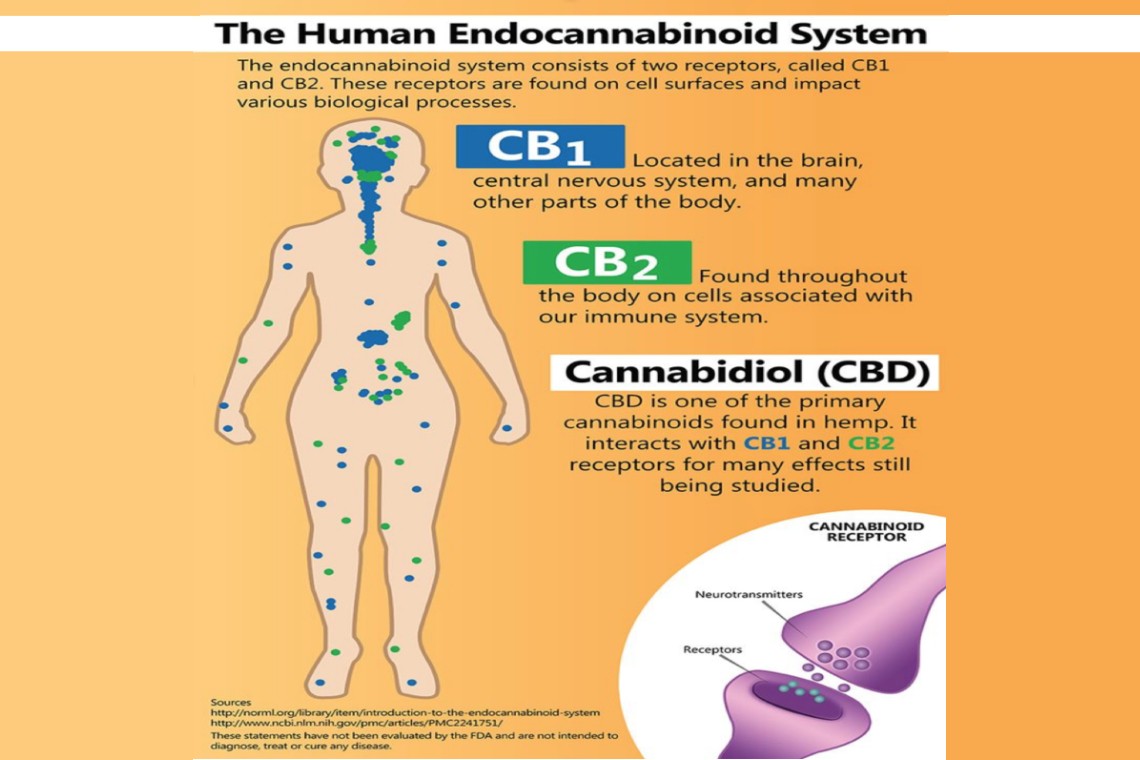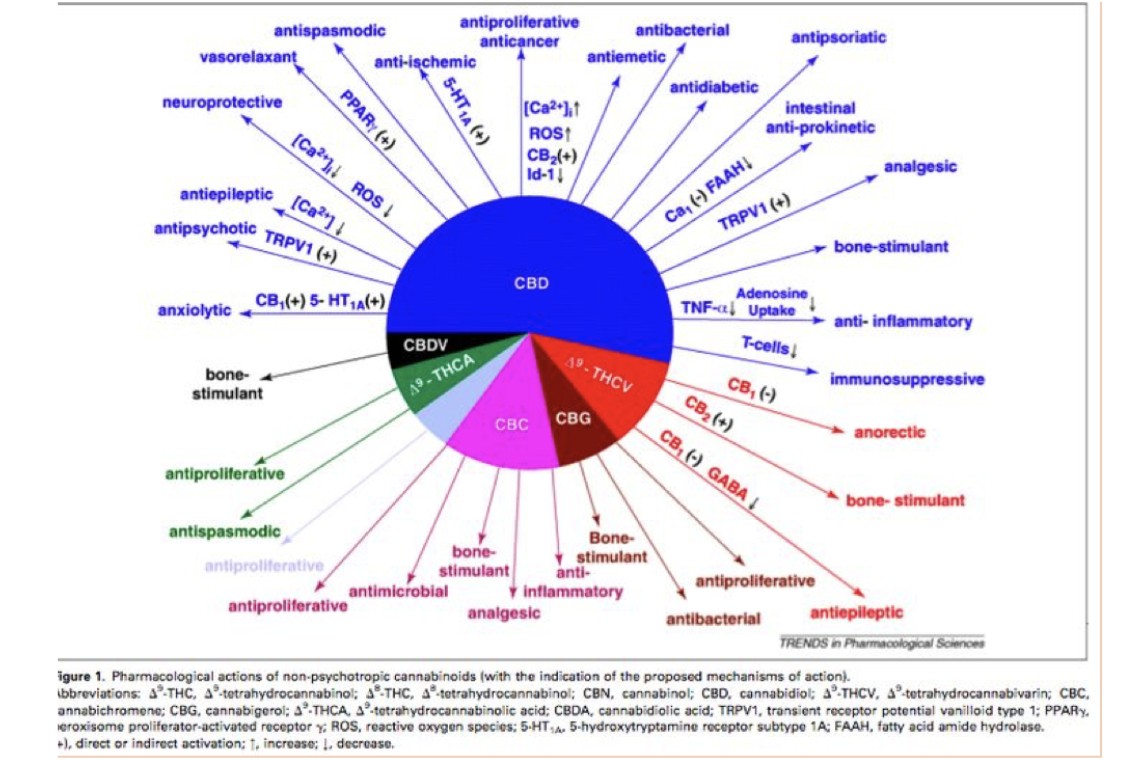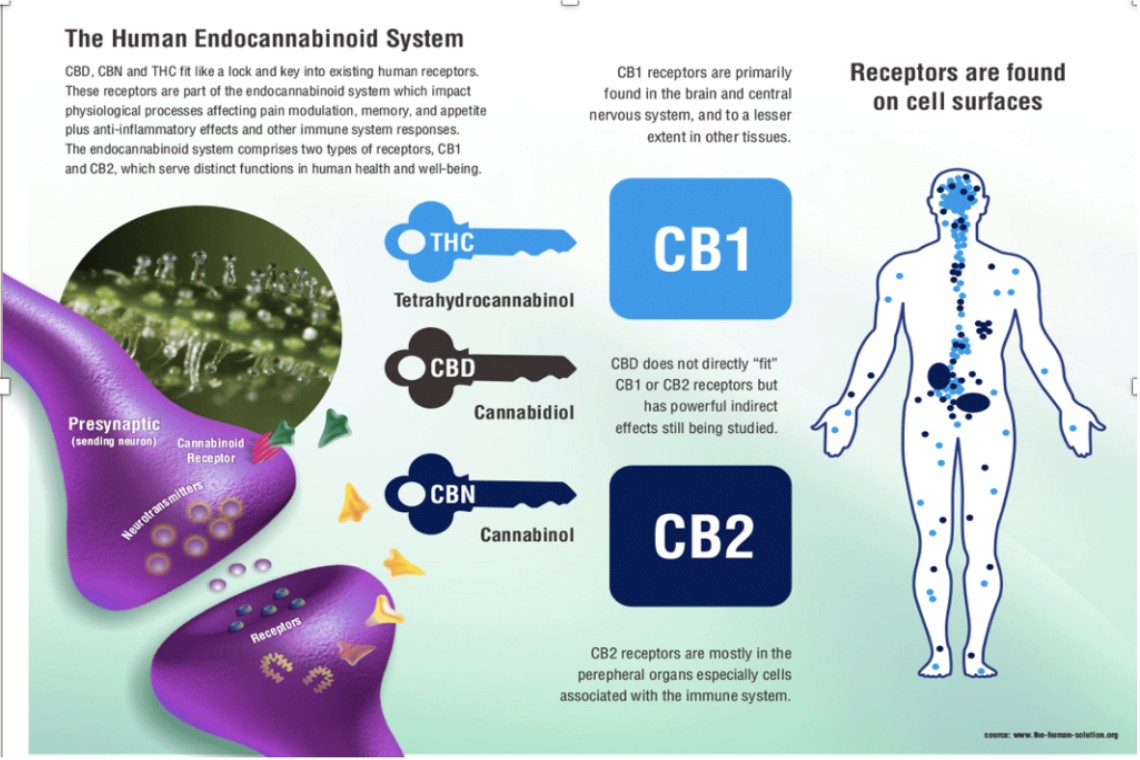Cannabinoids (Marijuana)
A Stem Cell Stimulator And Immune Modulator!

I recently returned from lecturing at the meeting of the American Academy of Anti-Aging Medicine. When I toured the exhibit hall I noticed there were a number of vendors selling various derivatives of Marijuana for medicinal use. Unfortunately, most of the sales people did not seem to have a true grasp on how the cannaboids, which are found in Marijuana, actually work in the body. I have written two blogs in the past about this medical phenomenon and would now like to give an update.
The diagram below gives us an idea of the various pharmacological actions of non-psychotropic cannabinoids. We can see that the effects are wide-ranging, affecting many different functions in the body. What we can assume is that ultimately these effects deal with the immune system and stem cells. These two entities go hand in hand.

The above diagram shows the various pharmacological actions of the many derivatives of Cannabis. Cannabinoid receptors are involved in a series of processes inside the human body, including the regulation of mood, pain sensation, appetite and memory. These receptors can be activated by endocannabinoids (produced by the human body) as well as by plant cannabinoids (like those found in hemp or cannabis), and they’re grouped in two main categories: CB1 and CB2. The above diagram shows the various components of the Cannabis plant.
These components can have very different effects on the body. Why is THC psychoactive and CBD is not? When we’re talking about cannabis and psychotropic activity, we’re dealing exclusively with cannabinoid 1 (CB1) receptors, which are concentrated in the brain and the central nervous system. The difference between CBD vs. THC comes down to a basic difference in how each one interacts with the CB1 receptor. THC binds well with CB1 cannabinoid receptors. CBD has low binding affinity for CB1 receptor. The following diagram shows this concept more vividly.

A THC molecule is perfectly shaped to connect with CB1 receptors. When that connection happens, THC activates, or stimulates, those CB1 receptors. Researchers call THC a CB1 receptor agonist, which means THC works to activate those CB1 receptors. THC partially mimics a naturally produced neurotransmitter known as anandamide, aka “the bliss molecule.” Anandamide is an endocannabinoid which activates CB1 receptors. The endocannabinoid system is so large and vital that almost every organ on the body expresses cannabinoid receptors. The system is a vital bridge between the body and brain, and endocannabinoids like anandamide are the messengers that keep the system running.
Animal studies have taught us that anandamide can increase appetite and enhance pleasure associated with food consumption, and it’s likely responsible for some of the rewarding effects of exercise (e.g. the “runner’s high”). Anandamide plays important roles in memory, motivation, movement, pain, appetite, fertility, even potentially inhibiting cancer cell proliferation. THC is a “key” that so closely resembles anandamide that it activates CB1 receptors, allowing it to produce some of those same blissful feelings.
CBD, by contrast, is not a good fit with CB1 receptors. It’s categorized as an antagonist of CB1 agonists. This means that it doesn’t act directly to activate or suppress CB1 receptors—rather, it acts to suppress the CB1-activating qualities of a cannabinoid like THC. In other words, when you ingest THC and CBD, the THC directly stimulates those CB1 receptors, while the CBD acts as a kind of modulating influence on the THC. CBD does not stimulate these two receptors; instead, it activates other receptors, like the vanilloid, adenosine and serotonin receptors. By activating the TRPV-1 receptor for example, cannabidiol (CBD) plays a role in the mediation of body temperature, pain perception and inflammation.
There are two forms of Cannabis, namely Marijuana and the Hemp plant. For cannabis to be legally considered hemp, it must contain no more than 0.3% tetrahydrocannabinol (THC) per dry weight. THC is the active compound in marijuana that causes its euphoric effect. The level of THC in hemp is 33 times less than the least potent marijuana strains, so it’s impossible for hemp to get a user “high.”
Unlike marijuana, hemp is naturally higher in cannabidiol (CBD), one of over 85 cannabinoids that have so far been identified in the cannabis plant. CBD is non-psychoactive and therefore won’t cause a high, making it safe for use by anyone, regardless of age.
In the US, more and more states are proposing the legalization of Marijuana. There are numerous health claims about hemp oil and other such medicinal products. There may be merit to some of these claims, including the action of Cannabis products on stem cells and the immune system.
There has also been some negative press. Recently, the FDA stepped in when a few companies were making claims about the use of Cannabis derivatives for the treatment of cancer. So far, there is not sufficient evidence of Cannabis as an anti-cancer compound. Thus, these claims need to be retracted. Possibly with more studies and research, these claims may prove to be correct. However, there is a good bit of scientific evidence out there that shows some interesting aspects of the Cannabis plant.
For those people looking for healthy benefits of Cannabis, we must realize that the compounds for health benefits typically do not have any hallucinogenic properties. Some time ago, I a wrote a blog about the use of certain components of the marijuana and Hemp plants. It remains relevant, so I am including it here in this update as follows:
“We used to think that marijuana was bad for one’s health. Now we are not so sure about it. We need to clarify things a bit.
Cannabinoids, the active components of cannabis (Cannabis sativa) extracts, have attracted the attention of human civilizations for centuries for a variety of uses. The use of Cannabis or Marijuana came before we were able to discover the active portion or substrate. This substrate is called endocannabinoid system. The endocannabinoid system has a number of components. The system consists of lipids, the receptors for the lipids and certain metabolic enzymes. The Cannabinoid signaling regulates cell proliferation, differentiation and it reduces cell aptosis or death. These receptors are found in the very early stages of life.
The results of the Cannabinoid receptors depend upon molecular targets and cellular context involved. There are two main receptors which are called CB1 and CB2 receptors. These receptors seem to be involved in neural degeneration and all three germ layer formations.
CB1 and CB2 show opposite patterns of expression, the former increasing and the latter decreasing along neuronal differentiation. It is thought that the CB2 receptors may be most important. Recently, endocannabinoid (eCB) signaling has also been shown to regulate proliferation and differentiation of hematopoietic and mesenchymal stem cells, with a key role in determining the formation of several cell types in peripheral tissues, including blood cells, adipocytes osteoblasts and osteoclasts, and epithelial cells. The developmental regulation of cannabinoid receptor expression and cellular/subcellular localization, together with their role in progenitor/stem cell biology, may have important implications in human health and disease.
Bone marrow and stem cells make endocannabinoids. These endocannabinoids interact with the cannabinoid receptors (Cannabinoid receptors have been found in nearly every cell in the human body). If cannabinoids can enhance stem cell migration and proliferation, this could be a powerful therapy. For instance, if you can increase the numbers and movement of stem cells to an injured tissue, you could vastly enhance the healing process.
Lastly, the synthetic cannabinoid HU-210 is about 100-1000 times more potent than THC from Cannabis and this synthetic agent has been found to be neurogenic. This means that HU-210 can cause new neurons (brain cells) in the brain to form. However, this study was done in rats… and humans are different from rats.
Will I prescribe medical marijuana for my stem cell patients? At present, I do not think I have enough information to make an intelligent decision about this. I suspect that if someday I do prescribe this, it will be some derivative of Cannabis. There are certainly some intriguing aspects of Cannabis, but I feel the jury is still out. I suspect we will certainly hear more about this. Thanks Dr. P”
I wrote that blog some time ago. At this juncture, I do believe that Cannabis derivatives are here to stay and will eventually be incorporated into mainstream medicine. I have further looked at the literature and there seems to be some very good science on the effect of Cannabis on stem cell workings.
One of the intriguing aspects of the CB2 receptor is that it is found mostly in the immune system. At the University of South Carolina, a team discovered that THC could reduce the inflammation associated with autoimmune diseases by suppressing the activity of certain genes involved in the immune response. Its presence in the immune system is of interest to scientists because the immune system triggers inflammation, and studies show marijuana can have an anti-inflammatory effect.
When we start talking about the immune system we have a host of implications. We are aware that many diseases of aging may have some basis as an auto-immune disease. One of these that interests me is Osteoporosis. Here, both receptors may be at work. CB-2 works on the immune system while CB-1 is induced during osteogenic differentiation.
Changes in endocannabinoid levels and/or CB2 receptor expressions have been reported in almost all diseases affecting humans, ranging from cardiovascular, gastrointestinal, liver, kidney, neurodegenerative, psychiatric, bone, skin, autoimmune, lung disorders, pain and cancer. The prevalence of this trend suggests that modulating CB2 receptor activity by either selective CB2 receptor agonists or inverse agonists/antagonists, depending on the disease and its progression, holds unique therapeutic potential for these pathologies.
I am still not at the point where I will prescribe the CBDs to patients. However, I will continue to watch and see how the science progresses.
More to come I am sure. Dr. Purita.
